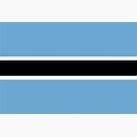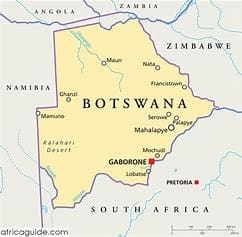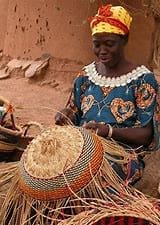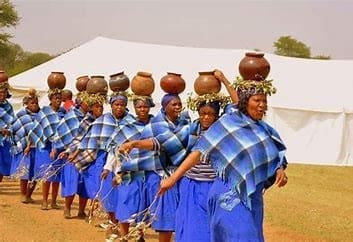Botswana is a country in Southern Africa that has rich and interesting clothing traditions. Many of them were formed under the influence of colonizers and missionaries who appeared in Botswana in 19-20th centuries. Today traditional Tswana outfit is a mix of Western-style or Victorian Era dresses with the pieces of clothing that are pure Tswana (for example, kaross – traditional blanket made from animal skins). Some costumes of ethnic minorities in Botswana also deserve special attention.
In general, we can divide the history of Tswana traditional clothing into 2 periods: pre-colonial period and missionary period. In accordance to this, we have 2 styles of clothing typical for this African country.
In pre-colonial period, Tswana people wore clothes made from skins and fur of local animals.


Men’s traditional outfit

Men wore a loin-skin called “tshega”, a “kaross” (rug or blanket made from animal skin), a skin cap, sandals and belt of tails (the latter is allowed only for warriors). And, of course, various ornaments were a very important part of a male costume. It could be copper wire necklaces, bead strings, armlets and etc.
Women’s traditional outfit
Women wore an apron in front called “khiba”, a skirt behind called “mosese”, a “kaross” to cover the upper body, and a lot of ornaments (necklaces, bracelets, rings, earrings etc.). A skin called “thari” was used by women to carry babies on their backs.
Children’s traditional outfit
Kids wore clothes that differ from adults’. Toddlers often didn’t use clothes at all. Older boys used a small flap of skin in front and nothing else. Though usually they also added ornaments to their dress. Girls wore a fringe of strings (made from skin or bast) and a lot of ornaments. When children got older, girls began to wear mosese and khiba, and boys – tshega.

Tswana people in traditional clothing made from animal skins.
Clothes made from animal skins often showed the social class, gender, age and status of people. For example, poorer Tswana used fewer pieces of clothing, and these garments were made from antelope skin. Rich Tswana, at the same time, wore coats made from 15-18 sewn together furs of such animals like wild cats, jackals, hears and similar.
The ornaments played an important role in the life of Tswana people. Tswana of every age and gender used them, and often in large quantities. Usually, Tswana ornaments were made from copper wire, leather, animal teeth etc. Later they began to trade with other tribes and countries, so they added glass beads and seashells to the list of materials.
To complement the traditional appearance of people in Botswana in pre-colonial period add the mix of ocher and animal fat which was used to cover the clothes and skin. Such ointment helped to protect the skin from the hot sun and rough winds. Nowadays Tswana people still use different ointment and cosmetics to protect their skin.
The missionary period in Botswana started in the mid-19th century. A lot of missionaries moved to Southern Africa in that period of time, and they brought some European traditions with them. One of the main new traditions was the clothing tradition. Missionaries wore more European garments and tried to dress local people in similar clothing. Gradually they managed to change the whole clothing tradition in Botswana. Locals began to discard garments made of animal skins and use fabric instead.


Tswana women in national costumes of the missionary period (Western-style dresses with Tswana traditional blankets).
Mary and Robert Moffat were the missionaries who caused the biggest change in traditional Tswana dress. During the 19th century, people in Botswana began to mix styles: they used modest European dresses combined with karosses (traditional blankets made from skins) or woven blankets. Such style of clothing emphasized the changes in Tswana lifestyle.
In the 20th century, Tswana people began to use Western-style clothing in everyday life. Their traditional outfits became rare at the streets of big cities. Today Tswana mostly wear garments made of animal skins for special occasions: weddings, ceremonies, folk events and traditional holidays.
Herero dress in Botswana
Besides Tswana people, Botswana is populated by some other ethnic groups. One of the biggest communities is Herero people. It is an ethnic group that inhabits several Southern African countries, including Botswana. They also have their unique traditional costume. After migration from their natural territory and several Herero wars with colonizers these people at last acquired new cultural features and traditions.
Today Herero people wear their national costume called “Herero dress”. It is derived from Victorian Era. This outfit was brought to Southern Africa by German missionaries in early 20th century. But nowadays Herero people consider it the part of their culture and clothing tradition.

Women in Herero dresses.
Herero dress is long and heavy. There are many petticoats underneath to make the dress puffy and wide. Herero dress covers most of the women’s body. Actually, it is a kind of indication that the woman is married and shows her body only to her husband.
Herero dress is complemented with an unusual hat. It is a horn-shaped headdress made from rolled cloth very similar to cow horns. Herero people are cattle farmers (it’s their main occupation), that’s why they chose such a strange headgear.
Herero dress is very popular in Botswana.
Leather Products

Leather products, such as carrying bags, dancing skirts, loin aprons, and hunting sets, are created through the joint efforts of males and females.
Men do the hunting, tanning, and sewing, while women are responsible for decorating the items with beadwork.
Beaded bags are used for carrying basic necessities like food and tobacco or when collecting roots, nuts, and melons.
Leather skirts and aprons, usually made with springbok, duiker, or steenbok skins, are the customary dress of the Bushmen.
Eggshell Jewellry

They adorn their leather products with beads either of colourful glass or ones crafted from hatched ostrich eggshells. They create exquisite necklaces, bracelets, and headbands.
Tortoise shell powder puffs, used for storing aromatic herbs, are decorated with beads.
Beads are knotted with hair from the wildebeest tail to make bracelets.
The making of beads from ostrich eggshells takes infinite care and skill. Hatched shells are broken into small pieces with fingers, stones or sometimes the teeth. In each piece, a small hole is drilled by turning an awl between the palms of the hands.
The beads are strung onto twisted sinew, then each is chipped into a round shape with the horn of a springbok and finally made smooth by rubbing the strand through a special grooved stone.
Baskets weaving of Botswana


Botswana is most famous for the basketry produced in the northwestern regions of the Okavango Delta by Wayeyi and Mbukushu women. Like most material arts in Africa, they have a practical purpose, but their intricate construction and evocative designs – with names like Tears of the Giraffe or Flight of the Swallows – are anything but.
In the watery environs of the delta, the baskets serve as watertight containers for grains and seeds. The weaving is so tight on some that they were also used as beer kegs. All the baskets are made from the leaf fibre of the real fan palm (mokolane) and colours are derived from soaking the fibres in natural plant dyes. The work is incredibly skilful and provides one of the most important sources of income for rural families.
One of the best places to purchase the work is the Shorobe Baskets Cooperative in Shorobe, north of Maun. another good place to browse for high-quality crafts is Botswanacraft in Gaborone.


Pottery
Traditionally, clay pots were used as an integral part of daily life, so making the step to crafting them as a commercial enterprise is a simple one. Clay pots are used for storing water and traditional beer, and also for cooking. Traditionally, the women within the community are responsible for collecting and moulding the clay, with the most sought-after clays being the kaolin-based ones that produce red and brown colours.

Once the form of the pot has been created, decorative patterns are added using natural oxides. Today, pots are produced mainly in the south and east of the country, where the best clay soils occur. There are commercial pottery centres in Thamaga, Molepolole, Kanye and Gaborone.
Wooden Crafts
Wooden crafts are produced throughout Botswana, but the Hambukushu and Basubiya people are the most renowned as artists. Products such as kitchen utensils, chairs, drums, thumb pianos and knives are commonly sold along the roadside or in the craft co-operatives that are found in most villages and towns.
The Hambukushu in northern Botswana are well known for their more artistic carvings, particularly of animals, and for the simple yet distorted style of their human figurines. The craft centres and shops in Gaborone, Ghanzi, Gumare, Serowe, Maun, Francistown and Kasane sell a good variety of wooden arts and crafts.

Mbukushu women carrying fishing baskets, Okavango Delta, Botswana
Bushman Art

The earliest artists were the Bushman people, masters of rock painting and supreme crafters, using either wood, leather or ostrich shell. Today, commercial products – based on the traditional forms of their bows and arrows used for hunting, their loin cloths, leather bags and beaded necklaces – can be bought in most co-operative outlets, found throughout Botswana.

Bushman artists have also more recently begun to achieve success with their very distinctive style of painting. Bright and full of human and animal images, the pieces mostly depict the deep connections their lifestyles have to nature.

the craft gallery here usually has some amazing works.
Article By Harshika Sapra
bibliography
nationalclothing.org
https://www.lonelyplanet.com
https://www.britannica.com
www.botswana.co.za
botswanacraft.com
https://kwekudee-tripdownmemorylane.blogspot.com

